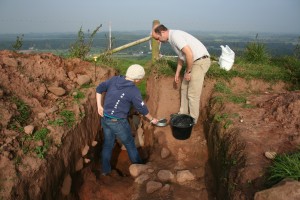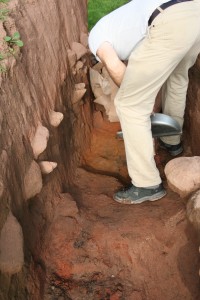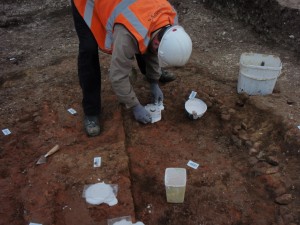 While Andy has been looking at some of the oldest rocks on Earth, some of us have been concentrating on more recent history. Studying the Earth’s magnetic field by the remanent magnetisation of archaeological artefacts is called archaeomagnetism. Here at Liverpool, we are always keen to hear from archaeologists who have uncovered burnt structures such as hearths or kilns. If we can take orientated samples back to the lab, we can tell what direction the magnetic field was pointing in when the feature last cooled down, “freezing in” the magnetisation. Not only can we use this information to see how the Earth’s magnetic field has evolved over time, once we have a good idea of how the field changed it is possible to give a date for the burning of the feature. We call this archaeomagnetic dating.
While Andy has been looking at some of the oldest rocks on Earth, some of us have been concentrating on more recent history. Studying the Earth’s magnetic field by the remanent magnetisation of archaeological artefacts is called archaeomagnetism. Here at Liverpool, we are always keen to hear from archaeologists who have uncovered burnt structures such as hearths or kilns. If we can take orientated samples back to the lab, we can tell what direction the magnetic field was pointing in when the feature last cooled down, “freezing in” the magnetisation. Not only can we use this information to see how the Earth’s magnetic field has evolved over time, once we have a good idea of how the field changed it is possible to give a date for the burning of the feature. We call this archaeomagnetic dating.
Here are a couple of sites that we looked at recently. Eddisbury hillfort in Cheshire was being excavated as part of the Habitats and Hillforts project being run by Cheshire West and Chester Council. The feature was above the hillfort’s ramparts, but below what looked like a Medieval field boundary. Archaeomagnetically, we think it’s probably from the 9th C.
This one was in Mildenhall, Suffolk, where excavations were being carried out prior to the building of a new supermarket. It’s a circular feature , about 2m across, with flints and river pebbles forming the edge, but it’s not clear what it was used for. There was little dating evidence on site, although there was Roman pottery from contexts above the feature. Archaeomagnetically, we thought it was Middle Iron Age, probably from the 4th C BC. Our models don’t let us date features much older than this, but as we collect more data, it may become possible.
